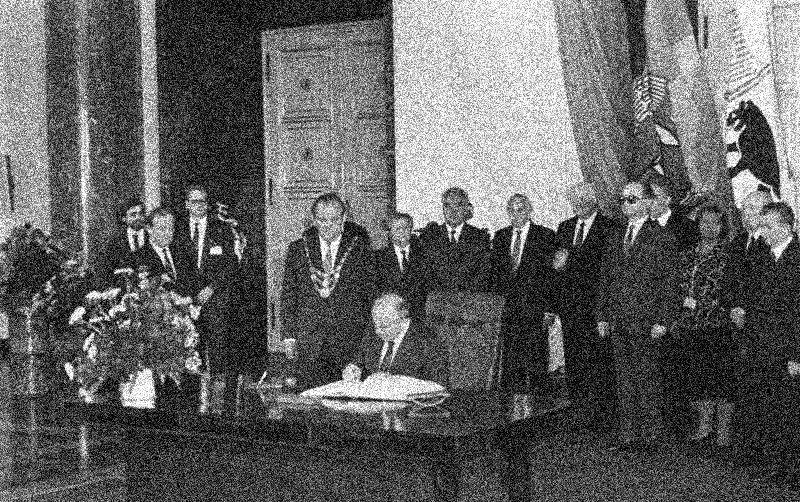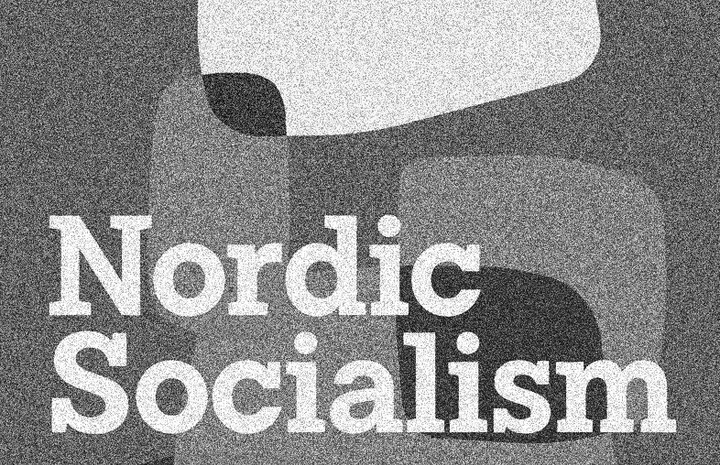How Capitalism Underwrote Its Own Stability in the Cold War
Fritz Bartel’s The Triumph of Broken Promises enhances our empirical understanding of why the Cold War ended when and how it did. But his book contains an ambivalent account of the importance of ideology in East and West that raises questions about its causal story.

Review of Fritz Bartel, The Triumph of Broken Promises: The End of the Cold War and the Rise of Neoliberalism (Cambridge: Harvard University Press, 2022).
For decades, the most influential literature on the end of the Cold War invoked the strong personalities, ideological commitments, diplomatic skills, and shrewd politicking of Ronald Reagan, George H.W. Bush, and Mikhail Gorbachev. Other works have emphasized the transnational activism of peace proponents and the spread of human rights and democratic ideals to citizens living under repressive governments in the Soviet Bloc. More recently, scholars have begun to explain the Cold War’s demise through the lens of the Soviet system’s economic inefficiency and structural contradictions.
The new book by diplomatic historian Fritz Bartel belongs mostly to this latter camp, but stands distinctly on its own, offering a materialist and structural account that weaves a tight narrative between global capitalism’s economic forces and the Cold War’s political outcomes, greatly enhancing our empirical understanding of how the Cold War ended. In The Triumph of Broken Promises: The End of the Cold War and the Rise of Neoliberalism, Bartel argues that energy and capital markets, by compelling states on both sides of the Iron Curtain to implement austerity after the 1973 oil crisis, transformed the fundamental nature of the Cold War from a competition between democratic capitalism and state socialism to make promises for economic prosperity and security to a race over which system could survive the impacts of having to break those promises. The West prevailed in this new political terrain of the Cold War, according to Bartel, because democratic capitalism proved more adept at breaking promises than did state socialism. The transition to neoliberal democracy in the Soviet Bloc meant the collapse of communism and the end of the Cold War.
The strength of Bartel’s work is that it shows—with astonishing archival research—how rising energy prices and ballooning debt constrained the policy options available to state managers in the West and East. Since the projects of both capitalist and socialist states to deliver on promises to the good life were based on energy-intensive industrial growth, the dramatic rise in oil prices that began in 1973 undermined these domestic social contracts. The oil price hike contributed to inflation in capitalist societies and imposed severe budget constraints on Eastern Bloc governments. Flooded with petrodollars from oil-producing states, global capital markets initially insulated Soviet Bloc states from the pressure to cut social spending, lending tens of billions of dollars to Eastern Europe by the early 1980s. “In a supreme irony,” Bartel writes, “it was only the development of global finance capitalism that allowed late socialism to exist. Without the explosive growth of global capital markets… the governing model of late socialism would have been impossible.” But this lifeline was only temporary. As the debt kept adding up, lenders began to hit the brakes, fearing a series of sovereign debt defaults that could trigger a global economic depression. The Soviet Bloc’s dependence on global capital markets and their gatekeepers in Washington became the defining element of the privatized Cold War.
In Bartel’s account, the key shift in the balance of power between East and West was the result of the West’s willingness and ability to break promises. The unequivocal end to postwar Keynesian and the commitment to full employment came with the infamous Volcker Shock, when Federal Reserve chairman Paul Volcker hiked interest rates in 1979 and 1981. Next came Ronald Reagan’s massive tax cuts, an offensive against organized labor, and the nation’s largest peacetime military buildup. Together these moves unleashed high levels of unemployment, deflation, and bankruptcy. It was this unquestionable shift in the balance of class forces in favor of capital that “created the perfect storm of attractive conditions for capital,” which poured in at “unimaginable” rates, underwriting the renewal of American economic power by financing Washington’s massive budget and balance-of-payments deficits.
This structural change in the global economy enabled the West to prevail in the Cold War. For one, it firmly ended the lifeline of unconditional sovereign lending to the Soviet Bloc. “The more the United States monopolized the world’s surplus capital,” Bartel writes, “the harder other governments found it to attract capital to their countries.” As the Soviet economy began to stagnate in the late 1970s, Moscow was compelled to prioritize its domestic social contract at the expense of economic aid to its allies, leaving the debt-ridden Eastern Bloc fully at the mercy of American-controlled Western lending institutions such as the International Monetary Fund. With loans now conditioned on political and economic transformations, one Soviet Bloc state after another began the transition to democracy and neoliberalism in 1989 and beyond. Moscow, itself with ballooning Western-owned debt, soon followed. Out went the Cold War.
While the sovereign debt crises of Latin America and Africa are well known, no other work has better told the story of Eastern Europe’s indebtedness and its role in bringing the Cold War to an end. From East Berlin to Warsaw, Bartel shows us communist officials in the process of coming to terms with the pressures toward austerity imposed by Western bankers and policymakers. Readers are left with an overwhelming sense of how the “coercion of creditworthiness” left Communist party officials with no alternative to a transition to democracy and market economy. “This is a story,” Bartel writes, “of how a conjuncture of pressures—sometimes purposeful, sometimes not; sometimes coordinated, sometimes not—emanated from Western governments, international institutions, and global capital holders to slowly winnow the choices available to Eastern Bloc leaders.”
To justify reform in Poland in 1989, Communist leader Wojciech Jaruzelski declared that without the West’s “funds, without these various connections, loans, [and] the postponement of some repayments, we will be unable to jumpstart the economy. It is simply out of the question, and it may even get worse.” To both appease western creditors and dampen widespread opposition to austerity, the party went so far as to legalize and empower Solidarity, the popular insurgent labor union that had already declared itself “probably the only labor union in the world” to welcome the IMF into its country. Only by democratizing Polish politics could structural adjustment become a reality. Even Gorbachev understood his ally’s lack of maneuverability. “We grumble about the Poles’ relationship with the IMF. But what can they do? The debt is $30 billion,” he told the Politburo in 1986.
In East Germany, as loans from its western neighbor became effectively conditioned on unification, state economist Alexander Schalck-Golodkowski complained, “Our problem is that we have debts to a political adversary who is working towards the liquidation of [East Germany]. This is the real danger.” On the day the Berlin Wall fell, he said, “The balance of payments . . . puts limits on us; it prevents us from making political decisions that would be necessary.”
The Triumph of Broken Promises also clarifies two key issues of the Cold War: the nature of the Soviet “empire” and the West’s role in bringing the Cold War to an end. While the USSR is often considered an empire in both popular and scholarly accounts, the picture Bartel paints is of the opposite of an empire as typically defined, wherein an imperial core siphons wealth and resources from its periphery. In Bartel’s account, Moscow’s satellites in Eastern Europe were unquestionably an economic burden on Russia.
As skyrocketing oil prices in the 1970s were making life hell for budget planners in the Eastern Bloc, Moscow forfeited the full earning potential on its massive oil production by selling the commodity to its allies at a subsidized price, a rolling average of the previous five years of world market prices. This arrangement, and the “breathtaking loss on the sale of the country’s most valuable asset” that it entailed, did not come easy. “How are we to explain to our people that we are selling our oil 30 rubles below the world market price?”, the Soviet foreign trade minister fumed to East German officials, making clear the costs of the subsidy to the Soviet home economy.
Throughout the 1980s, Bartel shows how Soviet leaders were constantly deliberating over the choice they faced between supporting their satellite states and maintaining their domestic social contract. Soviet economic stagnancy, financial chaos, and ballooning debt made it impossible to do both. “Saving the empire—or even slowing its dissolution—would have required significant economic discipline at home, while avoiding discipline at home required relinquishing the empire abroad,” Bartel writes. The periphery had become a net drain on the core.
Bartel’s story of the economic compulsions wrought by the shocks of the 1970s provides a much-needed modification of older “triumphalist” accounts that frame American victory in the Cold War as the result of Reagan’s hardline policies and crusading diplomacy. We shouldn’t interpret Triumph to suggest that the dynamics of capital accumulation did all the work in bringing about the Cold War’s demise with no meaningful role played by Western political leaders. It’s true that the asymmetry of power produced by the influx of capital to the United States and the collapse of creditworthiness in the Soviet Bloc was the result of the rational economic action of capitalists. When “a couple hundred panic stricken bankers” pulled their money out of the Soviet Bloc in the early 1980s, they did so “not out of Cold War animus,” Bartel writes, “but rather out of frightened concern for their balance sheets…. Communism had simply become a bad bet.” But we can more plausibly understand the structural changes in the global economy as the enabling conditions that empowered Reagan and other Western officials to negotiate outcomes to hot-button Cold War issues on terms overwhelmingly favorable to the West. Economic policymakers in the United States worked to produce those structural changes to restore profitability, not necessarily to win the Cold War, but their diplomatic counterparts certainly understood and exploited them to the West’s geopolitical benefit. The logic of capital accumulation enabled the world’s richest capitalist state to set the terms in the Cold War’s final years.
Even so, the ability to produce structural changes in the global economy in the first place was only made possible by the dollar’s global dominance and Washington’s controlling role in the major international financial institutions, which were themselves a product of America’s dominant position at the end of the Second World War. “The centrality of the US dollar to the entire world economy meant that when the United States finally decided to face its reckoning with broken promises, the rest of the world, including the communist states of the Eastern Bloc, had no choice but to reckon with broken promises too,” Bartel writes. By raising interest rates, Volcker made it far more costly for the Soviet Bloc to borrow in dollars.
Bartel’s account also neatly demonstrates capitalism’s universalizing drive to expand and subject increasing swaths of the globe to its will. The end of the Cold War is a story of capitalism imposing its imperatives on non-capitalist societies, specifically ones driven by firm anti-capitalist principles. After the economic shocks of the 1970s, the only way for the debt-ridden Soviet Bloc countries to return some normalcy to economic life was to compete with their capitalist rivals, a feat that required a shift to capitalist methods of production. Without such a transition, Eastern Europe would have continued to produce “flawed obsolescence,” leaving the well-being of its citizens dependent solely on foreign loans whose repayment hinged on selling goods that Westerners actually wanted to buy.
The great scholarly strength of The Triumph of Broken Promises is not only that it delivers a strong causal argument, but also that it clearly prioritizes the structural economic factors that previous accounts have typically ignored or obscured with ideological, cultural, or personal stories. By firmly connecting economic forces to political outcomes, Bartel enhances our empirical understanding of why the Cold War ended when and how it did.
On top of that structural account, however, Bartel adds an ideological layer that complicates and occasionally muddies his narrative. In explaining why capitalism survived the pressures toward austerity better than Soviet-style socialism did, Bartel cites the “political and ideological toolkit” afforded by neoliberal ideology and democratic elections as a fundamental source of stability. Neoliberalism “provided ideological justification for acts of breaking promises” and “made a virtue out of economic discipline.” Democratic elections “bestowed” a “sense of legitimacy or distance from past policy” on a new governing regime, providing it the trust it needed to break promises. “Lacking these tools,” Bartel writes, “the states of the Eastern Bloc democratized their political systems and reformed their ideology in the 1980s as a means of imposing economic discipline.” If promises were to be broken amid the opposition of workers in Eastern Europe, democracy and neoliberal ideology had to enter the equation.
When considered with his emphasis on the causal agency of economic structures, Bartel’s use of ideology raises the question of which mechanism, ideology or economic structure, was more fundamental in bringing the Cold War to an end. Did capitalism survive the pressures toward economic discipline because of its economic structure or because of neoliberal ideology? Did the Soviet model fail because it lacked the appropriate economy to impose economic discipline or because it lacked the right ideology to elicit consent from workers? The problem is that while the bulk of Bartel’s account overwhelmingly supports the structural explanation, he stops short of explicitly connecting the dots and instead elevates the role of ideology in a way that is less well-supported by his narrative.
Take, for example, his discussion of Gorbachev’s failed attempt at perestroika. The Soviet leader “found himself unable to transgress the popular will and ideological legacy of Marxism-Leninism. Unlike Reagan and Thatcher, he had no easy recourse to an ideological tradition of liberalism that prized individualism and made a virtue out of economic discipline,” Bartel writes. In this framing, it was the lack of an available ideology that blocked the path to economic reform.
But elsewhere, Bartel relies more heavily on the internal dynamics of the Soviet economic model to explain its collapse. He correctly identifies the “essence of reform” demanded by the structural changes in the global economy of the 1970s as the shift toward intensive economic growth—growth derived from overall increases in productivity; that is, producing the same or more economic output with fewer inputs, usually by introducing labor-saving technologies. Although capitalism possessed the proper incentive structure needed to increase productivity, Bartel argues, the Soviet model could only produce extensive growth—growth based on increasing inputs of labor and capital. “None of the stimuli that drove capitalist growth and efficiency were present in communist economies because the foundational promise of communism had been to protect workers from the exploitation of the capitalist system,” Bartel writes. Here it was not state socialism’s lack of neoliberal ideology that fundamentally undermined its ability to survive in the era of austerity, but rather its lack of an endogenous incentive structure to increase productivity, which enabled capitalism to respond to new economic imperatives more fundamentally than neoliberal ideology did.
In the West, Bartel argues that workers accepted broken promises only after the “promarket, anti-statist rhetoric”of neoliberalism and the blame-shifting “language of monetarism” won them over to the principle that the market should determine economic outcomes—not the government. But elsewhere, he suggests workers’ acceptance of declining living standards stemmed from their diminished structural power. After the Volcker Shock and Reagan offensive crushed the last vestiges of the labor movement, Bartel writes, “rather than fight for further gains, many workers simply rushed to secure what they already had.” Workers did so not because neoliberal ideology had convinced them that economic discipline was “virtuous”—nor does Bartel say so—but rather because they didn’t have the capacity to bring about a different outcome. It was more rational for workers to “secure what they already had” rather than “fight for further gains” in the 1980s.
Bartel is right to say that capitalism possessed better “tools to meet the challenge of breaking promises”; but by arguing that neoliberal ideology generated consent for austerity by “priz[ing] individualism and mak[ing] a virtue of out economic discipline,” he at times misidentifies what those tools are. Widespread resignation to the new social order was far more powerful than any ideological commitment. He is also right to attribute capitalism’s superior ability to impose austerity to the fact that “democratic capitalist governments made fewer promises to their people [than did state socialism], and this meant they had fewer promises to break,” but this phrasing almost attributes this fact to the varying levels of personal generosity among state managers across the Iron Curtain. The point is that the economic structures of each system conditioned this divergence, for the logic of capital accumulation sets endogenous limits on what can be promised in the first place. The particular ideologies of individual state managers reflected this reality.
Bartel correctly draws the causal arrow from structure to ideology. “[C]hange in the global economy… drove the adoption of new thinking within governments and societies,” he writes. But he is less clear on which mechanism was more fundamentally responsible for the divergent outcomes of capitalism and socialism in the late 1980s. The relationship between structure and ideology in the late Cold War still needs more explanation. Our ability to “achieve a world in which states sustainably keep their promises to all their citizens,” as Bartel implores on the last page of his book, hinges on a more precise analysis of capitalism’s persistence and the Soviet model’s collapse. By clearly connecting economic forces to political outcomes, The Triumph of Broken Promises goes a long way toward this end, giving us perhaps the best account to date of the end of the geopolitical conflict that dominated global politics for half a century.
■
Gunar Olsen is an independent writer and scholar whose work on U.S. foreign policy has been published in Jacobin, The New Republic, The Nation, and elsewhere.



